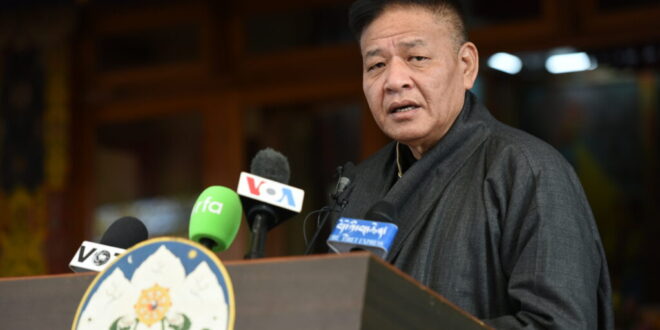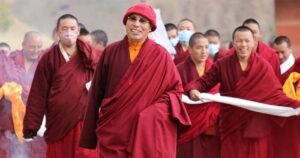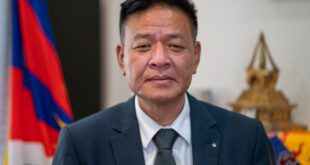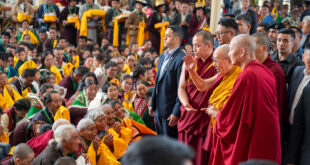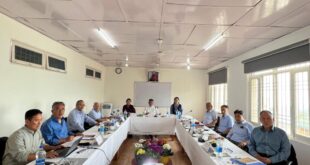On this special occasion of the 34th anniversary of the conferment of the Nobel Peace Prize to His Holiness the Dalai Lama, the Kashag offer its deepest gratitude and reverence to His Holiness the Dalai Lama. The Kashag also wish to extend its warm welcome to the dignitaries and guests who are present with us on this momentous occasion. We would also like to convey our hearty greetings to all the diaspora Tibetan communities and in particular the Tibetans inside Tibet.
His Holiness the Dalai Lama was awarded the prestigious Nobel Peace Prize in recognition of his extraordinary leadership in advocating world peace and promoting universal values for a happy life. His Holiness accumulated all these qualities based on his consistent and exemplary practice of compassion and altruism from a very young age. The Award was also in recognition of the Tibetan people’s steadfast commitment to the non-violent freedom struggle under the guidance and visionary leadership of His Holiness the Dalai Lama.
Alfred Nobel, the founder of the Nobel Prize and renowned scientist, was credited with inventing dynamite during the advent of the Industrial Revolution. He was deeply regretful and saddened at the misuse of his scientific invention for destructive ammunition and war. Therefore, he established the Nobel Prize foundation with a major part of his wealth to honour men and women from around the world for their outstanding achievements in physics, chemistry, medicine, literature and for work in peace. The conferment of Nobel Prizes in these fields began in 1901.
His Holiness the Dalai Lama has emphasised that the practice of compassion and wisdom is useful to all of humanity, especially to those responsible for running national affairs, in whose hands lie the power and opportunity to create the structure for a peaceful world. His Holiness has also emphatically stated over and over again that every human being wishes to live peacefully without conflict and hatred. His Holiness has also reiterated that problems can be successfully resolved with a clear and calm mind; whereas hatred, jealousy, and anger cloud our sense of judgment.
The previous century is said to be a century of war and bloodshed. More than 200 million people were killed in conflicts including the First and Second World Wars. It is the common aspiration of humanity to make the present century a Century of Dialogue and Peace. The simultaneous celebration of the Nobel Peace Prize Day and International Human Rights Day on 10th December reflect humanity’s common aspiration for the realisation of peace and human rights across the world. However, this aspiration is becoming more distant from us. There is no end in sight to the ongoing devastation in the Middle East conflict and Russia’s invasion of Ukraine, among other violent conflicts are matter of grave global concern. Moreover, nations are increasing their military budget in the name of national security, forming blocs and boosting military strength. The communist and authoritarian states are perpetrating and propagating genocidal governing policies by blatant violations of humanity’s fundamental freedom and human rights.
His Holiness the Dalai Lama said the conflict between Palestine and Israel in Gaza is unimaginable and expressed deep concern over why such sort of violence takes place among those people who claim to hold religious principles. Just four days after Russia’s invasion of Ukraine, His Holiness said our world has become so interdependent that violent conflict between two countries inevitably impacts the rest of the world, and emphasising that war is outdated and non-violence is the only way, His Holiness has stressed the need to develop a sense of the oneness of humanity by considering other human beings as brothers and sisters.
Last month, the People’s Republic of China’s government released its white paper titled “CPC Policies on the Governance of Xizang in the New Era: Approach and Achievements”. It claims that “the social and economic progress of Xizang epitomizes the nation’s outstanding achievements in development, created on the roof of the world through the Chinese path to modernization”.
The Chinese Communist Party (CCP) is now vigorously carrying out the extermination of the Tibetan identity in the name of “forging a strong sense of the Chinese national as one single community, promotion of the Chinese language, Sinicization of Tibetan Buddhism and developing socialist values”. Such infliction of suffering and oppression on the Tibetan people by the CCP authorities is unparalleled and unprecedented.
In 1935 and 1936, the Communist Red Army defeated by the government of Republic of China led by Chiang Kai-shek fled for their lives by retreating from Chaksam and Karze in Kham to northward along Ngaba, Barkham, Kakhog, Trochu, Sungchu, Dzoege and Thewo in Amdo. The hunger-stricken Chinese army looted food and properties from the Tibetans and plundered religious artefacts from the monasteries. Mao Zedong later admitted to journalist Edgar Snow that this is our only “foreign debt” referring to Tibet. Moreover, many Tibetans were killed when they revolted against the marauding Chinese army. For instance, 118 Tibetans from 27 families in Muto Village in Sungchu were massacred when they protested against the Chinese army for looting their grains. The Tibetan areas falling in the way of the three invading Red Army suffered calamitous famine unheard of in their history.
PRC’s invasion and occupation of Tibet resulted in the death of an estimated 1.2 million Tibetans and the destruction of over 6,000 monasteries until 1980. This is more devastating than the Armenian genocide of the early 20th century.
The white paper talks only about the “Tibet Autonomous Region” “(TAR)” and nothing about the situation in the Tibetan areas incorporated into the Chinese provinces. However, the policy of exterminating the Tibetan race is being enforced all across Tibet. The ploy applied in the name of inter-ethnic exchanges, communication and integration, is firmly to Sinicise Tibetans extensively in every section of the community, including rural and pastoral communities, schools and monasteries.
There has been a sharp increase in the appointment of Chinese cadres in the Tibetan areas. Although the white paper mentions a mere figure of “over 10,000 officials dispatched to assist Tibet”, it has not made public the number of appointments made in specific areas or in other forms. The Chinese government has highlighted its efforts in establishing job placement centres in 17 provinces in mainland China to employ around 95% of college graduates from the “TAR”, to integrate the younger generation of Tibetans into Han Chinese.
Likewise, the white paper touched upon measures to encourage inter-ethnic marriage in the name of ethnic unity as a legal obligation under the Five-Year Plan. But they have failed to mention the large-scale forced resettlement of Tibetans carried out under the pretext of environmental protection, infrastructure development and poverty alleviation. It claims that more than 200,000 people were lifted out of poverty and are supposed to have found jobs outside their hometowns. Reports of a considerable number of young Tibetans taken away to China in groups continue to emerge. For example, as part of a project to assist 40,000 workers in agricultural and pastoral areas in Tsochang Tibet Autonomous Prefecture to find employment, the Chinese government itself reported that a loan of 1 million yuan was doled out to help 640 workers open noodle restaurants in different parts of mainland China.
The Chinese government is vigorously accelerating the Sinicisation of Tibetan Buddhism. It forces Tibetan clergy to strictly adhere to socialist values and enhance the five identifications to represent the great motherland, the Chinese nation, the Chinese culture, the Chinese Communist Party and Socialism with Chinese characteristics. This is targeted at eroding the foundation of the study of Tibetan Buddhism based on Nalanda tradition to enable the promotion of the study of the Chinese language and ingrain communist ideology among Tibetan monks and nuns. The publication of “books on the interpretation of Tibetan Buddhist sutras” over a decade under the direction of the United Front Work Department is, in fact, a distortion of the Buddhist canons to fulfil the communist’s political objectives.
The “Democratic Management Committees” have established Communist Party Branches in Tibetan monasteries and nunneries in Tibet to regulate and surveil every aspect of the management of monasteries and religious activities. The monks are being indoctrinated with national consciousness, citizenship consciousness and rule of law consciousness in Tibetan society to “forge the consciousness of the Chinese nation community. Tibetans are coerced into hoisting the Chinese flag on the rooftops of monasteries and houses. Likewise, the photos of the five Chinese leaders from Mao to Xi are forced to be displayed in monasteries, public halls and houses.
The white paper says that “the reincarnated Tibetan living Buddhas, including Dalai Lamas and Panchen Rinpoches must be looked for within the country, decided through the practice of lot-drawing from the golden urn, and receive approval from the central government”. The official propaganda by the PRC is nothing but the absurdity of the Chinese leaders under the delusion of political paranoia. It is also a brazen rejection of the Buddhist doctrine of reincarnation, trampling of objectives of Trulku reincarnating to serve the Dharma, and ignorance of the present state of Tibetan Buddhism flourishing worldwide.
The Chinese government claims that the promotion of the common spoken and written Chinese language is aimed at protecting the “fine traditional Chinese culture and developing the spirit of communism, which has helped build a solid foundation for a sense of community for the Chinese nation”. However, behind this façade of propaganda, the Tibetan language is being systematically erased. The mass transfer of Tibetan students has accelerated from Kham and Amdo regions to schools in mainland China. Alarmingly, around one million primary Tibetan school children in Tibet are forcibly taken into boarding schools away from their families and their religion, their culture, their language, and their way of life.
Similarly, Tibetan language test in the recruitment exam for government posts in Tibet has been abolished and the medium of official communication among the administrative departments has been changed from Tibetan to Chinese. Moreover, those involved in initiatives to safeguard the Tibetan language are labelled political criminals and punished with imprisonment. Reports also indicate “Karze Tibetan Autonomous Prefecture” has issued a notice to ban the Tibetan language classes in primary to secondary schools in the region from next year. Since the teaching of the Tibetan language in schools is forbidden and staff recruitment exams in the Tibetan language are abrogated, there is no space for using the Tibetan language. The intent, therefore, is to erase Tibet as a race from the face of this earth.
The white paper talks about so-called achievements in literary and artistic works such as forging ahead in the New Era, radio, TV, exhibitions and museums as educational bases for patriotism, and protection of Chinese culture in the name of cultural and ethical development, that has nothing to do with the preservation and promotion of Tibetan religion, culture and tradition. Rather it clearly shows how Tibetans are forced to praise and imbibe communist ideology. Despite the CCP’s claims about economic investments in a plethora of projects and results achieved, these are not intended for the well-being of the Tibetans, but to facilitate the Chinese government to easily control Tibet, exploit Tibet’s natural resources and surveil Tibetans. The building of the so-called nature reserves and national parks, which cover over one-third of the Tibetan area, is akin to colonial powers seizing land from the natives.
As part of its broader Sinicisation policy, the term Tibet is being replaced with “Xizang” in pinyin in the white paper. Moreover, the names of places between cities such as Lhasa to villages are being changed from Tibetan to Chinese. The sole objective of the PRC in replacing Tibet with the term “Xizang” is to wipe out Tibet from the world map and subsequently hope that Tibet will fade away from the memories of people in the world to assert its unfounded legitimacy.
China’s Tibet policies are aimed at obliterating the nearly 1,400 years rich Tibetan language; Sinicise Tibetan Buddhism founded on Buddha’s teaching on equality without discrimination based on caste, power and territory; eradicating Tibetan culture ingrained with compassion and non-violence; and assimilating the distinct Tibetan race into the majority Han. Such miscalculated strategies and misguided policies are untenable and bound to fail. When the Tibetans were faced with choosing the Nalanda tradition of Indian Buddhism and Chinese Hoshang’s meditative practice that has penetrated the upper echelons of King Trisong Detsen’s court that infringes on the regulation and practice at Samye Monastery, the decision of the emperor to follow the Indian tradition has helped Tibet to preserve the Buddhist faith in its pristine form and quality.
The extermination of Tibetan identity under Mao’s repressive policies marks the darkest period in our history. Notwithstanding utter destruction, under His Holiness the Dalai Lama’s extraordinary leadership and with the perseverance of Tibetans in exile and the unshakable determination of our brethren in Tibet, not only the Tibetan culture and religion been preserved and promoted within a short time but also continues to remain alive and flourish worldwide including in the Himalayan regions.
We call upon the Chinese Communist Party to immediately end its blatant violation of the Law on Regional National Autonomy guaranteed in the Chinese Constitution and cease policies and programs aimed at extermination of the Tibetan identity. If the Chinese government does not put an end to these policies, it will cause irreparable wounds in the hearts and minds of the Tibetan people that will impact the harmonious relationship between the Tibetan and Chinese peoples as neighbours since ancient times. Being a signatory to the Convention on the Prevention and Punishment of the Crime of Genocide adopted by the United Nations 75 years ago on 9 October 1948, the CCP should be held accountable for violating the terms of this international law.
Finally, we hope and pray that peace prevails around the world and everyone enjoys freedom and human rights across humanity. We pray for the long life of His Holiness the Dalai Lama so that He can spend the rest of his life for the promotion of world peace and moral values. May truth and the non-violent cause of Tibet prevail.
The Kashag,
10 December 2023
